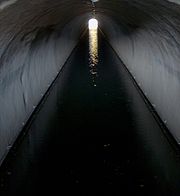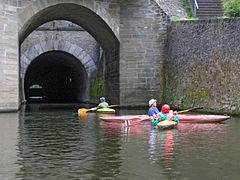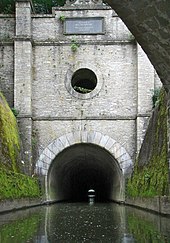Weilburg shipping tunnel
The Weilburger Schifffahrtstunnel is the oldest and longest still passable ship tunnel in Germany. It crosses under the Mühlberg, on which the town of Weilburg is located, over a length of 195 meters , from north to south and thus avoids an approximately two-kilometer-long curve of the Lahn with two weirs. The tunnel was built between 1844 and 1847 and today, together with the parallel road and rail tunnels, forms the so-called Weilburg tunnel ensemble .
history
In the early 19th century, the Nassau government began to make the Lahn, on which shipping from the mouth to Diez was already operated in the Middle Ages , also to make the upper reaches of the river navigable. Before that, the river was only partially usable there, as sandbanks, stone weirs and rapids made it impossible to transport goods with larger ships. This stood in the way of the increasing industrialization of the upper Lahn valley, which had come to Nassau from Limburg in 1806 through the secularization of the spiritual property. In particular, the local quarries and ore mines needed better transport links.
From 1809 the Lahn could be used as far as Runkel , in 1810 it was regulated as far as Weilburg. From then on, the Weilburger Lahnschleife represented the biggest remaining obstacle. For a few kilometers, the river has a height difference of 4.65 meters. The rapid course of the river with its rapids was tamed in the Middle Ages by two weirs , which now stood in the way of further expansion. In 1816 Nassau and Prussia (the area around Wetzlar had just become Prussian) negotiated a regulation of the Lahn as far as Gießen in order to connect the city and the surrounding ore mines to the Rhine and the up-and-coming coal and steel industry of the Ruhr area. In the long term, the Lahn was to be connected to the Elbe via a canal and thus create an inland waterway between it and the Rhine (instead, the Mittelland Canal was built almost a century later ).
To bypass the two weirs, the idea of the shipping tunnel was finally born in 1838. This envisaged breaking through the Weilburg ridge below the Landtor and building a lock to compensate for the difference in altitude . After lengthy planning, the Nassau government finally gave its approval to the expensive project on July 18, 1843. With the execution of the project have been Obernberg councils Schapper and Grandjean and bailiffs Haas and Schenk entrusted. Completion was planned for 1845, but unexpected difficulties in the construction work delayed progress, so that the Weilburg shipping tunnel could not be inaugurated until September 18, 1847.
Just ten years after its opening, the Lahn shipping and with it the shipping tunnel lost their importance to the Lahn Valley Railway, which was built in 1857 . Today the tunnel is mainly used by rowers , canoeists and other water sports enthusiasts.
construction
A coupling lock , which was built between 1844 and 1847 and has to be operated by hand, is connected to the 195 meter long tunnel on the south side . This compensates for the height difference of 4.65 meters that was created by shortening the Lahn loop. Each of the two lock chambers is 42 meters long, with part of the lock system located inside the tunnel. The water depth in the tunnel is 1.75 meters, the tunnel width is 5.6 meters, the tunnel height at the apex of the tube is 6.3 meters. The inner walls of the tunnel are lined with bricks and clad with concrete. The tunnel portals on the north and south sides are made of Lahn marble . In total, over 10,000 cubic meters of rock were removed from the mountain to create the tunnel.
Inscription of the north portal
The following Latin inscription is inscribed in the north portal:
"ADOLPHUS DUX NASSOVIAE MONTIS JUGUM PERFOSSUM NAVIBUS APERUIT AD MDCCCXLVII"
The German translation reads: " Adolph Herzog von Nassau pierced the back of the mountain and opened it to the ships AD 1847".
literature
- Falko Lehmann: District Limburg-Weilburg , + Volume 2: Mengerskirchen to Weinbach = monument topography Federal Republic of Germany . Vieweg + Teubner, Braunschweig 1994, pp. 769 f, 790, ISBN 3-528-06243-6 .
- Rudolf Müller: Shipping tunnels and water reservoirs - historical water structures in Weilburg (in: Hessische Heimat , Volume 61), 2011, pp. 45–52 ( http://www.weilburg-lahn.info/pdf/weilburger_wasserbauten_endnoteV3_web.pdf PDF, 17 pages ).
Web links
- State Office for Monument Preservation Hessen (Ed.): Schifffahrtstunnel In: DenkXweb, online edition of cultural monuments in Hessen
- www.weilburg-lahn.info
Remarks
- ↑ In the former Rüdersdorf limestone quarry , the Heinitz Canal, which is now used as a club room, and the Bülow Canal, which still carries water but is no longer navigable, which was built in 1816, are still preserved. Both were tunnels that were used to transport the rock from the quarries to the Spree and Havel by barges. In 2013 two shorter ship tunnels were built in the course of the Koschen Canal (connection between Senftenberger See and Geierswalder See ), with which the federal highway 96 and the Black Elster are crossed.
Coordinates: 50 ° 29 '0.7 " N , 8 ° 15' 57.3" E






